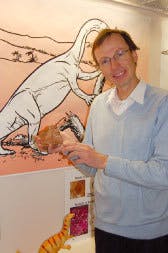The first discovery of dinosaur remains in Norway has now been scientifically proved.
The fossilized bones were discovered by Morten Bergan, a geologist with German oil and gas producer RWE Dea AG. Bergan discovered the remains in a well in Snorre field, Norway’s second largest oil field.
Not only were these the first such remnants found in Norway, but also they were found at a world record-breaking depth for the discovery of dinosaur remains, at 2,256 m below the seabed.
Snorre, in which RWE Dea Norge AS has an 8.88% stake, is 210 km northwest of Bergen under the Norwegian North Sea, which has a depth of 290-380 m. The dinosaur bone was discovered in the main reservoir formation.
The method of discovery was a little unusual, too. Bergan found the remains after they were hit by a drill bit on well 34/4-9S in 1997. While analyzing core samples from the oil well, the geologist noticed a tube-like white structure that resembled a bone.
Authentication
Then entered German paleontologist Nicole Klein, who specializes in the bone histology of herbivorous dinosaurs.
At the University of Bonn, Klein and other scientists examined rich Plateosaurus material found in south Germany and Switzerland. Comparisons confirmed a match. Klein and her team determined that the bone fragment that Bergan found belongs to a Plateosaurus.
The herbivorous Plateosaurs lived around 200 million years ago in the late Triassic age. At that time, the region of the Lunde formation was a wide plain formed by the sediment of large rivers and was crossed by the long-necked dinosaurs. They were presumably able to walk on all fours as well as stand upright on their hind legs.
Research also shows that the Plateosaurs probably caused the ground to shake around them when they moved, as they were as tall as 10 m and weighed 4 tonnes.
“The bone from the Snorre oil field exhibits several features which are characteristic of Plateosaurus, including the radial fibro-lamellar bone tissue as well as the typical growth rings. Given the very high vascular density of the outer bone wall, it can be assumed that the creature died at a young age,” Klein stated in her findings.
Rare find
Fossilized dinosaur bones previously had been found all over Europe but never in Norway, as the ancient rock formations in mainland Norway are too old to reveal any traces of dinosaurs.
Bergan is proud of being the discoverer of the first Norwegian dinosaur. “It’s taken 9 years, but now we finally know the animal to which the bone belongs and what this dinosaur looked like and how it lived.” Bergan said.
Klein and her colleagues have published their findings in the Norwegian Journal of Geology, and the dinosaur bone is now on exhibit at the Museum of Natural History in Oslo.



